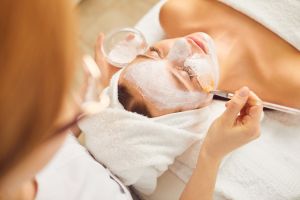What is a Chemical Peel?
In the ever-evolving world of skincare, chemical peels have emerged as one of the most effective and popular treatments for achieving healthier, more radiant skin. Whether you’re dealing with acne scars, sun damage, fine lines, or simply want to refresh your complexion, chemical peels offer a scientifically-backed solution that can transform your skin’s appearance. But what exactly is a chemical peel, and how does it work its magic?

Understanding Chemical Peels: The Science Behind the Glow
A chemical peel is a dermatological treatment that uses a carefully formulated chemical solution to remove damaged layers of skin, revealing the fresher, healthier skin underneath. Think of it as a controlled form of exfoliation that goes far deeper than any scrub or exfoliating product you might use at home.
The process works by applying an acid solution to the skin, which causes the top layers to gradually peel away over the course of several days to weeks, depending on the depth of the peel. This controlled damage triggers the skin’s natural healing response, stimulating the production of new collagen and elastin while accelerating cell turnover.
The Three Levels of Chemical Peels
Chemical peels are categorised into three main types based on how deeply they penetrate the skin:
Light Peels (Superficial Peels)
Light peels are the gentlest option and work on the outermost layer of skin, the epidermis. These peels typically use alpha hydroxy acids (AHAs) like glycolic acid or lactic acid, or beta hydroxy acids (BHAs) like salicylic acid. They’re perfect for beginners or those with sensitive skin who want to improve their complexion without significant downtime.
Light peels can help with mild acne, minor sun damage, uneven skin tone, and rough texture. They’re often called “lunchtime peels” because you can literally have one done during your lunch break and return to work immediately afterward. The results are subtle but cumulative, with most people needing a series of treatments to achieve their desired outcome.
Medium Peels
Medium peels penetrate deeper into the skin, reaching the upper portion of the dermis. They typically use trichloroacetic acid (TCA) or a combination of acids to achieve more dramatic results. These peels are ideal for treating moderate sun damage, age spots, fine to moderate wrinkles, and more pronounced acne scarring.
With medium peels, you can expect more noticeable peeling and a longer recovery time, usually around one to two weeks. The results, however, are more significant and longer-lasting than light peels. Your skin will likely appear red and swollen initially, followed by several days of peeling as the damaged skin sheds away.
Deep Peels
Deep peels are the most intensive option, penetrating deep into the dermis using strong acids like phenol. These peels are reserved for severe skin damage, deep wrinkles, and significant scarring. Due to their intensity, deep peels are typically performed only once and require extensive downtime for healing.
The recovery process from a deep peel can take several weeks to months, during which the skin will be red, swollen, and sensitive. However, the results can be dramatic and long-lasting, sometimes permanent. Deep peels are usually performed by plastic surgeons or dermatologists in a medical setting due to their complexity and potential risks.
What Skin Concerns Can Chemical Peels Address?
Chemical peels are remarkably versatile and can address a wide range of skin concerns:
Acne and Acne Scarring: Salicylic acid peels are particularly effective for acne-prone skin, as they can penetrate into pores to remove excess oil and dead skin cells. For acne scarring, deeper peels can help smooth out uneven texture and stimulate collagen production.
Sun Damage and Age Spots: Chemical peels excel at removing damaged skin cells caused by UV exposure, helping to fade dark spots and create a more even complexion.
Fine Lines and Wrinkles: By stimulating collagen production and removing damaged skin layers, chemical peels can significantly reduce the appearance of fine lines and even some deeper wrinkles.
Uneven Skin Tone and Texture: Whether caused by acne, sun damage, or natural aging, chemical peels can help create smoother, more evenly toned skin.
Melasma: This common pigmentation condition often responds well to chemical peels, particularly those containing kojic acid or hydroquinone.
Large Pores: While peels can’t actually shrink pore size, they can make pores appear smaller by removing debris and improving overall skin texture.
The Chemical Peel Process: What to Expect
Understanding what happens during a chemical peel can help alleviate any anxiety and ensure you’re properly prepared for the experience.
Consultation and Preparation
Before any peel, you should have a thorough consultation with a qualified practitioner. They’ll assess your skin type, discuss your concerns and goals, and determine the most appropriate type of peel for your needs. You may need to prepare your skin for several weeks beforehand by using specific products to optimise results and minimise complications.
The Treatment
On the day of your peel, your skin will be thoroughly cleansed and degreased. The chemical solution is then carefully applied to the treatment area using a brush, cotton pad, or gauze. You’ll likely feel a stinging or burning sensation, which is normal and indicates that the peel is working. The solution is left on for a specific amount of time before being neutralised or naturally stopping its action.
Post-Treatment Care
After the peel, your practitioner will provide detailed aftercare instructions. This typically includes using gentle, fragrance-free skincare products, avoiding sun exposure, and applying broad-spectrum sunscreen religiously. Following these instructions is crucial for achieving optimal results and preventing complications.
Recovery and Results: What to Expect
The recovery process varies significantly depending on the depth of your peel:
For light peels, you might experience mild redness and slight peeling for a few days, similar to a mild sunburn. Many people can return to their normal activities immediately.
Medium peels involve more dramatic peeling that can last 7-14 days. Your skin will likely be red and swollen initially, followed by significant peeling as the damaged skin sheds. It’s important to resist the urge to pick at peeling skin, as this can lead to scarring or infection.
Deep peels require extensive recovery time, with initial healing taking 2-3 weeks and full results becoming apparent over several months. During this time, strict sun avoidance and careful wound care are essential.
Potential Risks and Considerations
While chemical peels are generally safe when performed by qualified professionals, they do carry some risks:
Infection: Any time the skin barrier is compromised, there’s a risk of bacterial, viral, or fungal infection. Proper aftercare and hygiene are crucial for prevention.
Scarring: Though rare, scarring can occur, particularly with deeper peels or if post-treatment instructions aren’t followed properly.
Pigmentation Changes: Some people may experience temporary or permanent changes in skin colour, particularly those with darker skin tones.
Allergic Reactions: While uncommon, some individuals may have allergic reactions to the chemicals used in peels.
Choosing the Right Professional
The success and safety of your chemical peel largely depend on choosing a qualified, experienced practitioner. Look for board-certified dermatologists, plastic surgeons, or licensed aestheticians working under medical supervision. Don’t be swayed by bargain prices, as chemical peels require expertise and high-quality products to be performed safely and effectively.
Maximising Your Results
To get the most from your chemical peel investment, consider these tips:
Follow all pre and post-treatment instructions carefully. Use high-quality skincare products recommended by your practitioner. Maintain a consistent skincare routine between treatments. Protect your skin from sun damage with broad-spectrum SPF 30 or higher. Consider combining peels with other treatments like microneedling or laser therapy for enhanced results.
The Bottom Line
Chemical peels represent one of the most effective ways to improve skin texture, tone, and overall appearance. Whether you choose a gentle lunchtime peel or a more intensive treatment, the key to success lies in working with a qualified professional who can customise the treatment to your specific needs and skin type.
While the idea of deliberately damaging your skin might seem counterintuitive, chemical peels harness your body’s natural healing processes to reveal healthier, more youthful-looking skin. With proper care and realistic expectations, chemical peels can be a transformative addition to your skincare routine, helping you achieve the clear, radiant complexion you’ve always wanted.
Remember, beautiful skin is a journey, not a destination. Chemical peels can be an excellent tool in that journey, but they work best as part of a comprehensive approach to skincare that includes daily protection, proper cleansing, and regular professional maintenance. Your skin is unique, and your treatment plan should be too.
